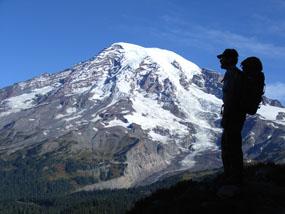With the National Park Service and the Federal Aviation Administration sitting down to consider scenic overflights of Mount Rainier National Park, the National Parks Conservation Association wants the agencies to consider a broad range of options, including a ban on the overflights.
The two federal agencies currently are working on an Air Tour Management Plan and associated Environmental Assessment for Mount Rainier pursuant to the National Parks Air Tour Management Act of 2000.
The NPCA, citing public safety concerns, potential impacts to wildlife habitat, and potentially adverse experiences for the millions of people who visit Mount Rainier annually, in its comments on the overflight proposal called on the FAA to consider broad alternatives for flight management, including no flights at all. The group also called for the completion of a legally required Environmental Impact Statement (EIS) on the issue.
“We go to places like Mount Rainier National Park to get away from the sights and sounds that surround us in our daily lives, like aircraft buzzing overhead,” said Sean Smith, NPCA’s policy director and private pilot. “Given the iconic wilderness that surrounds Mount Rainier, sightseeing overflights — if not properly managed — can disrupt natural sounds, dislocate wildlife, and reduce visitor enjoyment.”
NPCA recommends that the FAA and the Park Service consider or include the following as the federal Air Tour Management Plan process continues for Mount Rainier National Park:
Public Safety
Mount Rainier National Park’s topography and unpredictable weather challenges even experienced pilots. Over the past 50 years there have been at least 15 aviation crashes in the park resulting in 68 deaths. The park’s topography and weather also make search and rescue operations difficult, so the plan should include expected costs of search and rescue efforts.
Visitor Experience
With nearly half the park in subalpine, alpine or ice environments, air tour noise has the ability to impact large sections of the park where there is no tree cover, as well as the experience of most park visitors.
Wildlife Habitat
The wildlife that lives in the park’s various habitats will each react differently to air tours. The assessment must pay particular attention to high elevation wildlife such as the Pika, Marmot and Mountain Goat, as they will bear a disproportionate burden of these impacts.
Alternatives
The Environmental Assessment should include these three alternatives for analysis:
1. No commercial air tours over the park (focus on viewing the mountain from airspace beyond the park boundary).
2. Commercial air tours capped at the current level of 114 per year, with existing percentages of helicopters and fixed-wing aircraft.
3. Commercial air tours capped at the current level of 114 per year, with stricter limits on helicopter tours as a percentage of total tours.
You can find the park advocacy group's full comments in the attached PDF.




Comments
I am So glad to see this conversation come to the table. Soundscape is such a huge part of the national park experience. I hear visitors comment here at Grand Canyon about the wonders of nature's sounds which they can actually hear.